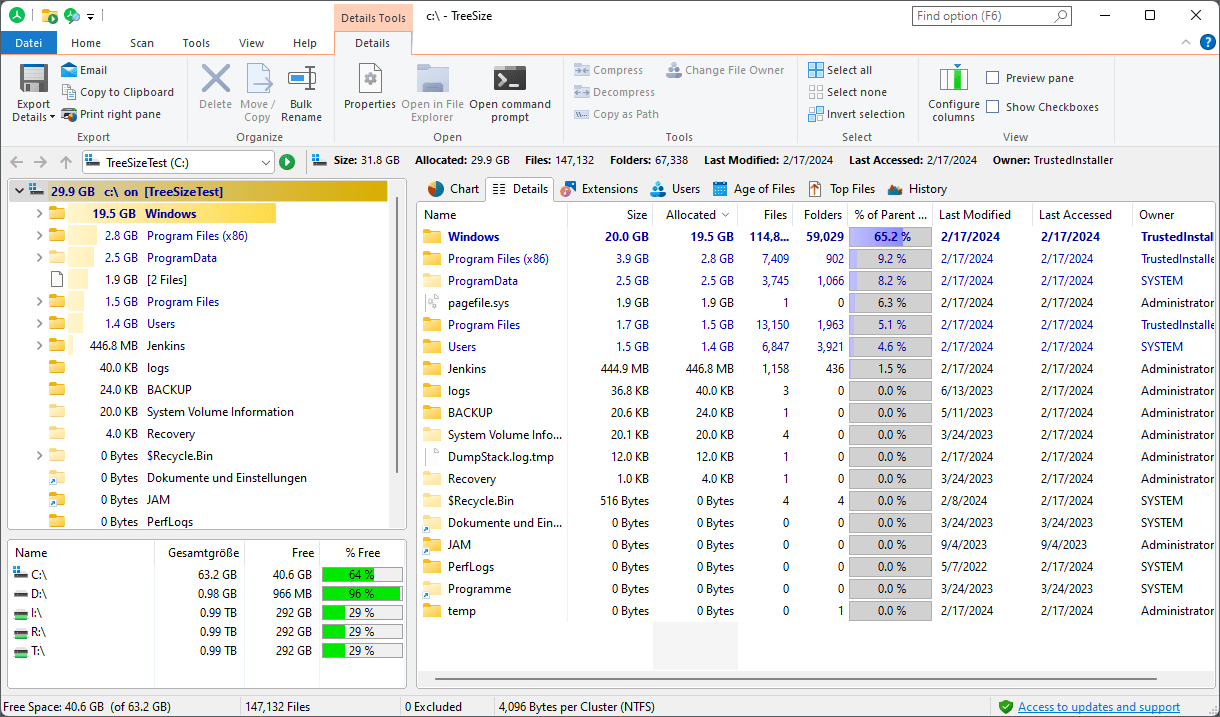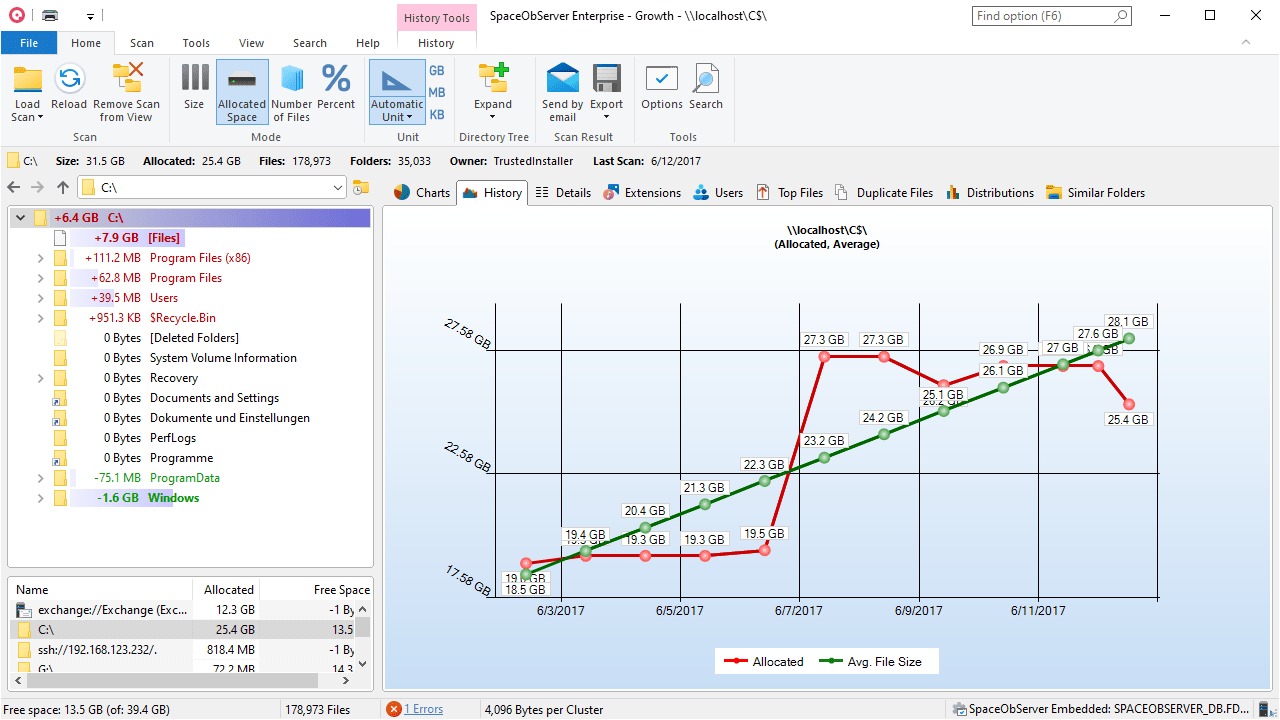How To Keep The Data Explosion Under Control
Save time, money and nerves with storage management automation

In today's cloud age, data volumes are growing at an unprecedented rate. And the numbers speak for themselves:
In 2010, 2 zettabytes of data were generated worldwide. In 2020, just 10 years later, this figure has increased to 32 zettabytes!
If we follow this trend, forecasts predict that we will end up with a breathtaking 181 zettabytes of data by 2025. In other words, more than five times the measured value from 2020.
Coping with this immense amount of data is a challenge, but it also offers plenty of opportunities.
The proper use and analysis of this data can improve strategic decision-making and promote advanced analytics, automation and artificial intelligence (AI).
But how can you keep this data explosion effectively in check and even reduce costs in the long term? Let's take a closer look.
The hidden challenges of data management
While direct costs such as additional hard disks and electricity costs for storage solutions or cloud storage are usually obvious, the indirect costs of this development are usually much higher.
The effort involved in managing the databases is a challenge that should not be underestimated:
When IT staff spend hours or even days sorting, backing up and storing data, valuable time is lost that could be used more effectively.
Loss of time due to data management
But what are the tasks that ultimately cause time and costs? These include, among others:
- Compliance with data protection laws and guidelines that prescribe how personal data must be collected, processed, stored and deleted.
- Optimizing storage space by identifying and removing redundant, duplicate or unnecessary data.
- Managing access rights and data security by defining who can see, edit or share which data.
For every hour that IT employees spend on these tasks, the indirect costs for the company increase - not only due to the corresponding labor costs, but also due to the lost business value that could result from more productive activities.
Quantifying these so-called opportunity costs can be difficult, but it is clear that they are significant.
However, many of these recurring tasks can easily be completed independently.
With smart software running in the background at set intervals, employees could use their skills for strategic and more productive tasks.
Those who react now are preparing themselves for the future and the competition. After all, the automation of processes is already widespread in companies.
The trend towards automation
A McKinsey study from 2020 already clearly showed where the trend is heading. At that time, almost a third of all companies had already fully automated a process.
With the advent of generative AI, its qualitative improvement and the increasingly powerful and locally usable models of the future, this process will certainly accelerate.
The question is no longer whether companies should rely on automation and the automation of their storage management, but to what extent and using which technologies.
Next, let's take a look at the various automation options.
Automation has many facets
The technical foundations for successful implementation are multifaceted. They range from state-of-the-art storage solutions and cloud computing to sophisticated algorithms that turn big data into manageable information.
In order to exploit the full potential of these technologies, companies must critically scrutinize both their internal processes and their IT infrastructure and adapt them if necessary.
The practical possibilities are also diverse.
Automated backup solutions and intelligent data archiving systems enable companies to drastically reduce their storage costs, for example.
At the same time, the availability and recoverability of data can be significantly improved, ensuring a high level of operational reliability.
However, intelligent backup systems are only half the battle unless you effectively exclude redundant or outdated data from backups.
Unfortunately, the changeover is usually not that simple, as manual processes and structures often still stand in the way.
Away from manual processes and towards efficient automation
The sustainable and effective use of automation technologies also requires a change in corporate culture: away from manual, error-prone processes and towards a more resilient operating model supported by automation.
This process is not always easy and can present the following challenges, among others:
- Resistance to change: Employees may resist new technologies out of fear of the unknown or fear of losing their jobs.
- Skills gaps: The introduction of new automation technologies requires special knowledge and skills that may be lacking in the existing team.
- Lack of strategy and vision: Without a clear direction and understanding of how automation can support business goals, the foundation for successful implementation is often missing.
- Integration into existing systems: The integration of new technologies into existing IT infrastructures and processes can pose technical and operational challenges.
So how can we meet these challenges?
It is important for management to communicate the changes clearly and show employees that their work will be supported by automated processes and not replaced. In addition, there should always be an open ear for legitimate concerns and fears in order to be able to counteract them quickly.
Automation strategies for storage management
In order to optimize the constantly growing storage requirements while maintaining the same performance and number of employees, companies are already and increasingly relying on automation tools that provide decisive relief in the management of storage resources.
Strategies for optimizing digital storage space
A central element of storage optimization is data lifecycle management. This means that data is managed automatically throughout its entire existence, from its creation to its deletion.
Policies and workflows are generated that consider the age of the data, thereby systematically identifying and cleaning up old data without the need for manual intervention.
Data lifecycle management not only helps to reduce storage requirements and costs, but also improves the clarity of data stocks, as only relevant and up-to-date data is stored.
In addition, efficient storage usage is further optimized through the automated detection and deletion of duplicate files. Algorithms scan the storage systems and identify redundant data, which can lead to savings and improved data integrity.
In an environment where data security and integrity are of paramount importance, these mechanisms are also a key component of risk mitigation.
Manage storage space and data efficiently
Another aspect of data management is the management of storage space, especially in cloud environments.
Cloud-based storage solutions offer scalability and flexibility, but without effective control of storage usage, costs can get out of hand over time. This is where TreeSize and SpaceObServer come in.
TreeSize serves as an ad-hoc tool for a quick overview of storage usage on various local and cloud platforms. It offers a user-friendly interface, similar to Windows Explorer, right down to a detailed view of individual files.
TreeSize can effectively visualize storage space and provides useful analyses, such as lists of the largest files or storage distribution by user and file type.
SpaceObServer is recommended for comprehensive and automated data management. As TreeSize's big brother, SpaceObServer focuses on the long-term monitoring and automation of storage space management using an integrated database.
With continuous monitoring for detailed reporting, SpaceObServer enables cost-efficient decisions.
Learn more about the benefits of TreeSize and SpaceObServer and start automating your data management today!
Start automating storage management today
Now that we've taken a comprehensive look at the goal behind storage management automation and possible approaches, it's time for you to define your own next steps.
We hope this article has helped you understand the concept and benefits of storage management automation and wish you the best of luck!



